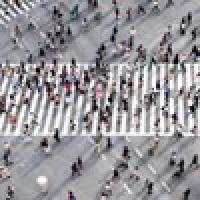
Maths in a crowd
Many things in nature seem to be striving for a purpose: ants and bees appear to follow a collective goal, flocks of birds to move in a carefully choreographed dance, and the patterns on animal coats to be painted by a divine artist. Yet, in all these example the overall pattern is just a result of many individuals interacting while following simple rules. They are emergent phenomena. In this series of articles Chris Budd looks at some examples of emergence and explores how it can be modelled, and explained, using maths.
These articles are based on a talk in Budd's ongoing Gresham College lecture series. You can see a video of the talk below.
The selfish herd — From flocks of starlings to spiral galaxies: this article explores examples of emergent phenomena in nature.
Cellular automata — Find out how a square grid and some simple rules can generate complex patterns and life-like behaviour.
The dynamics of crowds — Human beings are wilful and don't always act rationally. Yet, mathematical models of the behaviour of crowds are surprisingly accurate.
Emergence and the dynamics of crowds: The podcast — In this podcast Chris Budd talks to us about the concept of emergence and how to model the behaviour of crowds of people. We also explore cellular atomata in one minute.
About the author
Chris Budd OBE is Professor of Applied Mathematics at the University of Bath, Vice President of the Institute of Mathematics and its Applications, Chair of Mathematics for the Royal Institution and an honorary fellow of the British Science Association. He is particularly interested in applying mathematics to the real world and promoting the public understanding of mathematics.
He has co-written the popular mathematics book Mathematics Galore!, published by Oxford University Press, with C. Sangwin, and features in the book 50 Visions of Mathematics ed. Sam Parc.